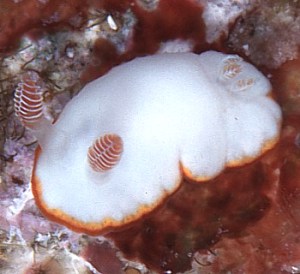About Noumea subnivalis
August 18, 2001
From: Nishina Masayoshi


Dear Dr.Rudman,
I am a amateur but I have tried to consider the issue you raised about the identity of Noumea subnivalis.
Here is my translation of the Japanese part of Baba's original description.
"Mantle edge is surrounded with bi-colour of outer orange and inner yellow. Coloration of upper half of the rhinophore is reddish purple. Gills are white ... The mantle back has a small tubercles. The back is pure white (snow white) without any sign of orange-red spots on it. Tip of tail foot is not dyed yellow."
First. His description of the mantle edge doesn't actually mention two separate 'bands' so I feel that he is not necessarily talking about a clear boundary between orange and yellow. It can be conjectured to be an ambiguous boundary line. Secondly, He wrote just "rhinophore is...", no more detail description. No mention about which part of the rhinophore. And lastly, I particularly noticed that he mentioned "small tubercles on the back". I thought this was significant because my animal has it. It is very difficult to see it but I feel they are small tubercles.
Please refer to the attached images which are of the same animal. Date: 11 Aug, 2001
Location, Echizen Beach. Depth: 7m. Size: 15mm. (this is the same place that Baba refers to in 1987. [Baba, K (1987): Noumea sp. from Echizencho Coast, Japan. Janolus, 69: 2.) Echizen Beach is on the Echizencho Coast of Japan. Upper Photo by Nishina Chikako, Lower Photo by Kahoru Imamoto.
So, if you think if my animal is Chromodoris verrieri too, I also think that N. subnivalis is a synonym of C. verrieri.
Best Regards,
Nishina Masayoshi
nishina@hpe15.wips.co.jp
Nishina, M., 2001 (Aug 18) About Noumea subnivalis. [Message in] Sea Slug Forum. Australian Museum, Sydney. Available from http://www.seaslugforum.net/find/5100
PHOTO: C. verrieri, 6 mm long, Kerama Is. Photo: Atsushi Ono.
Dear Nishina,
Thanks very much for your thoughts and the extra photos, they are very useful. These photos and your translation of the Japanese section of Baba's description certainly clarify the external differences between N. subnivalis and C. verrieri. Although there were clear anatomical differences, Baba's description of the external colour was not totally clear. However your photos showing the nature of the mantle border and the papillae on the mantle certainly fit Baba's description. I have included alongside Atsushi Ono's photo of an animal from Kerama Is which I identified earlier as C. verrieri for comparison. It is a 6mm long juvenile and yet we can clearly see the distinct red and orange-yellow bands around the mantle edge. Quite different from your 15mm animal where the colour gradually changes from red through orange to yellow.
I think we can use the nature of the coloured mantle border and the mantle papillae as the important external distinguishing features of this species. I'm afraid it doesn't help to identify of the animal in Yasuhiro Shirai's recent photo. To me the colour border is in two distnct bands so I think it is probably best to consider it to be C. verrieri.
And please don't apologise for being an amateur. The word 'amateur' comes from the Latin word for 'love' and basically means someone 'who does what they do out of love for it' - and we can't ask much more than that. 'Amateurs' have always been an invaluable source of information for me. Professionals can't afford to ignore the observations of interested amateurs who vastly outnumber the few people worldwide who are lucky enough to be employed to study sea slugs. One of my major reasons for starting the Forum was to provide a place where amateurs could record their observations so that they would be available to us all and where their participation could be acknowledged.
Thanks again,
Bill Rudman
Related messages
-
Southernmost record of Noumea subnivalis
From: Nishina Masayoshi, September 26, 2002 -
Re: Noumea subnivalis?
From: Yasuhiro Shirai, August 21, 2001 -
Another photo of Noumea subnivalis
From: Nishina Masayoshi, August 21, 2001 -
Noumea subnivalis? from Japan
From: Yasuhiro Shirai, August 14, 2001
